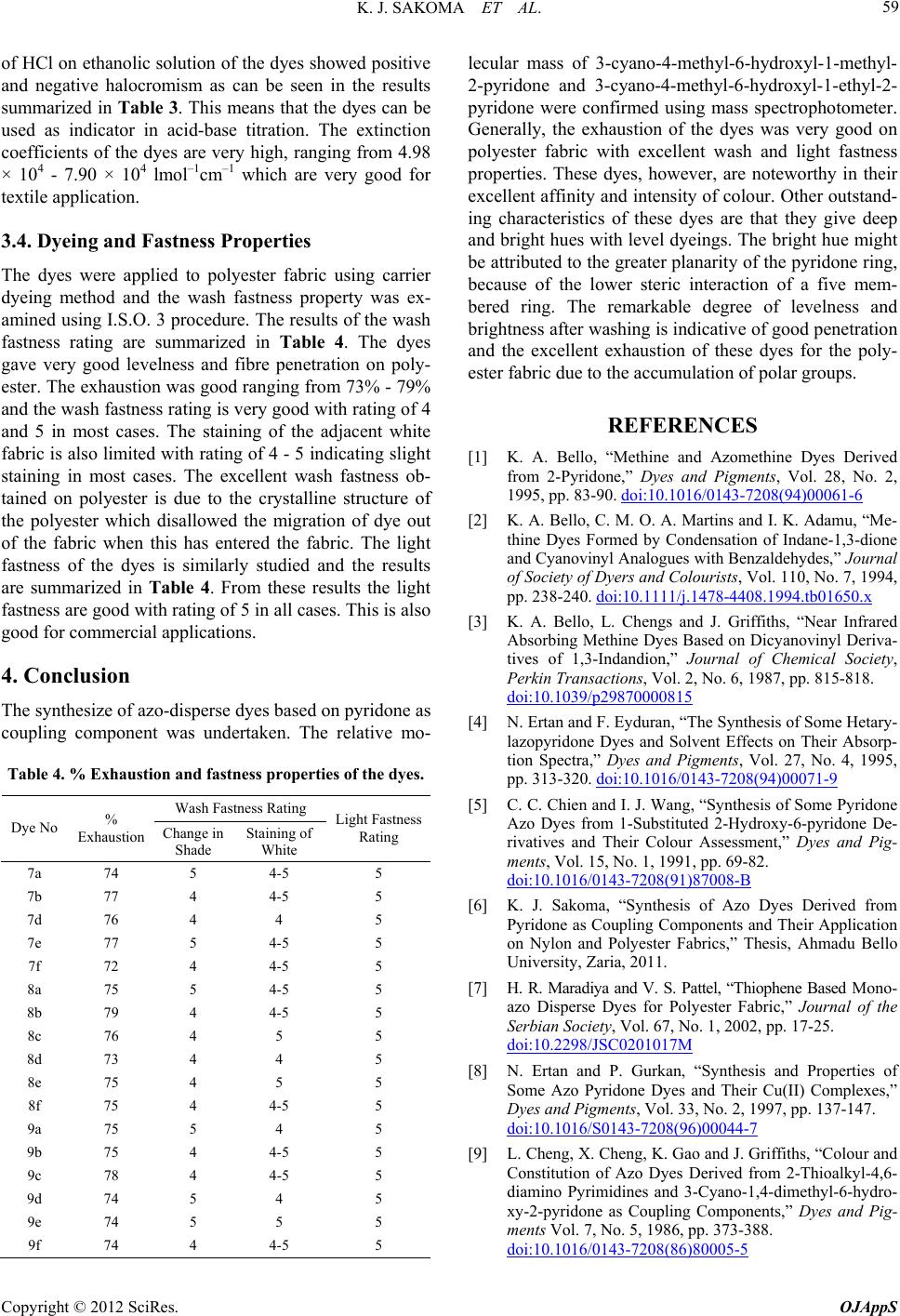
K. J. SAKOMA ET AL. 59
of HCl on ethanolic solution of the dyes showed positive
and negative halocromism as can be seen in the results
summarized in Table 3. This means that the dyes can be
used as indicator in acid-base titration. The extinction
coefficients of the dyes are very high, ranging from 4.98
× 104 - 7.90 × 104 lmol–1cm–1 which are very good for
textile application.
3.4. Dyeing and Fastness Properties
The dyes were applied to polyester fabric using carrier
dyeing method and the wash fastness property was ex-
amined using I.S.O. 3 procedure. The results of the wash
fastness rating are summarized in Table 4. The dyes
gave very good levelness and fibre penetration on poly-
ester. The exhaustion was good ranging from 73% - 79%
and the wash fastness rating is very good with rating of 4
and 5 in most cases. The staining of the adjacent white
fabric is also limited with rating of 4 - 5 indicating slight
staining in most cases. The excellent wash fastness ob-
tained on polyester is due to the crystalline structure of
the polyester which disallowed the migration of dye out
of the fabric when this has entered the fabric. The light
fastness of the dyes is similarly studied and the results
are summarized in Table 4. From these results the light
fastness are good with rating of 5 in all cases. This is also
good for commercial applications.
4. Conclusion
The synthesize of azo-disperse dyes based on pyridone as
coupling component was undertaken. The relative mo-
Table 4. % Exhaustion and fastness proper tie s of the dye s.
Wash Fastness Rating
Dye No %
Exhaustion Change in
Shade
Staining of
White
Light Fastness
Rating
7a 74 5 4-5 5
7b 77 4 4-5 5
7d 76 4 4 5
7e 77 5 4-5 5
7f 72 4 4-5 5
8a 75 5 4-5 5
8b 79 4 4-5 5
8c 76 4 5 5
8d 73 4 4 5
8e 75 4 5 5
8f 75 4 4-5 5
9a 75 5 4 5
9b 75 4 4-5 5
9c 78 4 4-5 5
9d 74 5 4 5
9e 74 5 5 5
9f 74 4 4-5 5
lecular mass of 3-cyano-4-methyl-6-hydroxyl-1-methyl-
2-pyridone and 3-cyano-4-methyl-6-hydroxyl-1-ethyl-2-
pyridone were confirmed using mass spectrophotometer.
Generally, the exhaustion of the dyes was very good on
polyester fabric with excellent wash and light fastness
properties. These dyes, however, are noteworthy in their
excellent affinity and intensity of colour. Other outstand-
ing characteristics of these dyes are that they give deep
and bright hues with level dyeings. The bright hue might
be attributed to the greater planarity of the pyridone ring,
because of the lower steric interaction of a five mem-
bered ring. The remarkable degree of levelness and
brightness after washing is indicative of good penetration
and the excellent exhaustion of these dyes for the poly-
ester fabric due to the accumulation of polar groups.
REFERENCES
[1] K. A. Bello, “Methine and Azomethine Dyes Derived
from 2-Pyridone,” Dyes and Pigments, Vol. 28, No. 2,
1995, pp. 83-90. doi:10.1016/0143-7208(94)00061-6
[2] K. A. Bello, C. M. O. A. Martins and I. K. Adamu, “Me-
thine Dyes Formed by Condensation of Indane-1,3-dione
and Cyanovinyl Analogues with Benzaldehydes,” Journal
of Society of Dyers and Colourists, Vol. 110, No. 7, 1994,
pp. 238-240. doi:10.1111/j.1478-4408.1994.tb01650.x
[3] K. A. Bello, L. Chengs and J. Griffiths, “Near Infrared
Absorbing Methine Dyes Based on Dicyanovinyl Deriva-
tives of 1,3-Indandion,” Journal of Chemical Society,
Perkin Transactions, Vol. 2, No. 6, 1987, pp. 815-818.
doi:10.1039/p29870000815
[4] N. Ertan and F. Eyduran, “The Synthesis of Some Hetary-
lazopyridone Dyes and Solvent Effects on Their Absorp-
tion Spectra,” Dyes and Pigments, Vol. 27, No. 4, 1995,
pp. 313-320. doi:10.1016/0143-7208(94)00071-9
[5] C. C. Chien and I. J. Wang, “Synthesis of Some Pyridone
Azo Dyes from 1-Substituted 2-Hydroxy-6-pyridone De-
rivatives and Their Colour Assessment,” Dyes and Pig-
ments, Vol. 15, No. 1, 1991, pp. 69-82.
doi:10.1016/0143-7208(91)87008-B
[6] K. J. Sakoma, “Synthesis of Azo Dyes Derived from
Pyridone as Coupling Components and Their Application
on Nylon and Polyester Fabrics,” Thesis, Ahmadu Bello
University, Zaria, 2011.
[7] H. R. Maradiya and V. S. Pattel, “Thiophene Based Mono-
azo Disperse Dyes for Polyester Fabric,” Journal of the
Serbian Society, Vol. 67, No. 1, 2002, pp. 17-25.
doi:10.2298/JSC0201017M
[8] N. Ertan and P. Gurkan, “Synthesis and Properties of
Some Azo Pyridone Dyes and Their Cu(II) Complexes,”
Dyes and Pigments, Vol. 33, No. 2, 1997, pp. 137-147.
doi:10.1016/S0143-7208(96)00044-7
[9] L. Cheng, X. Cheng, K. Gao and J. Griffiths, “Colour and
Constitution of Azo Dyes Derived from 2-Thioalkyl-4,6-
diamino Pyrimidines and 3-Cyano-1,4-dimethyl-6-hydro-
xy-2-pyridone as Coupling Components,” Dyes and Pig-
ments Vol. 7, No. 5, 1986, pp. 373-388.
doi:10.1016/0143-7208(86)80005-5
Copyright © 2012 SciRes. OJAppS